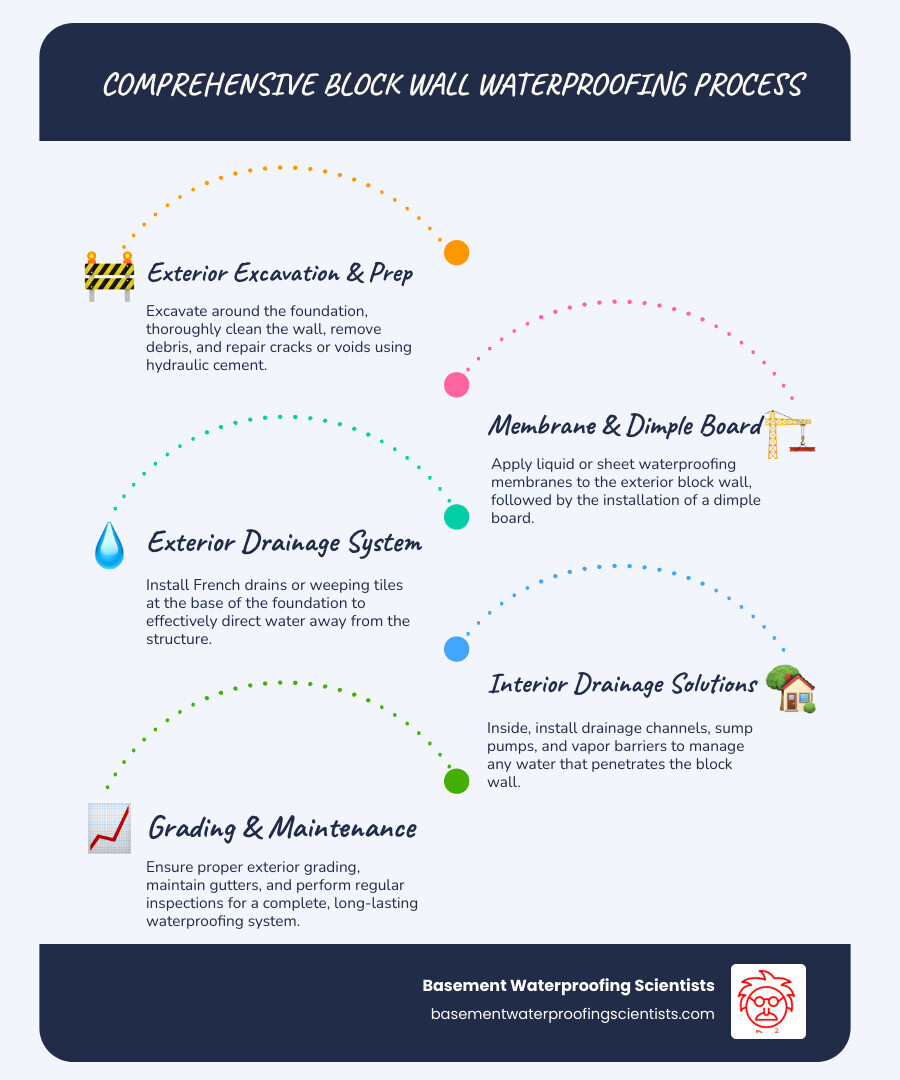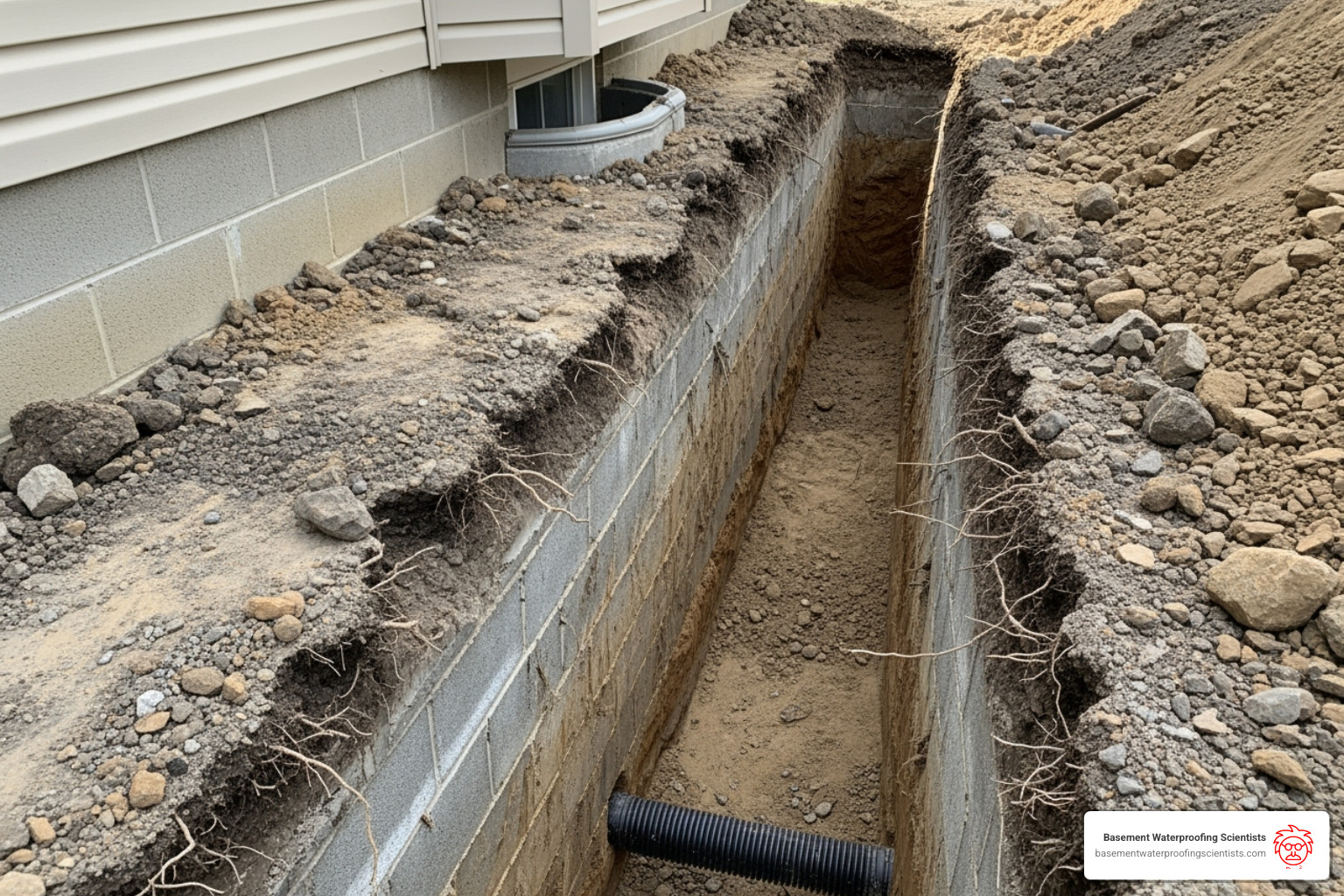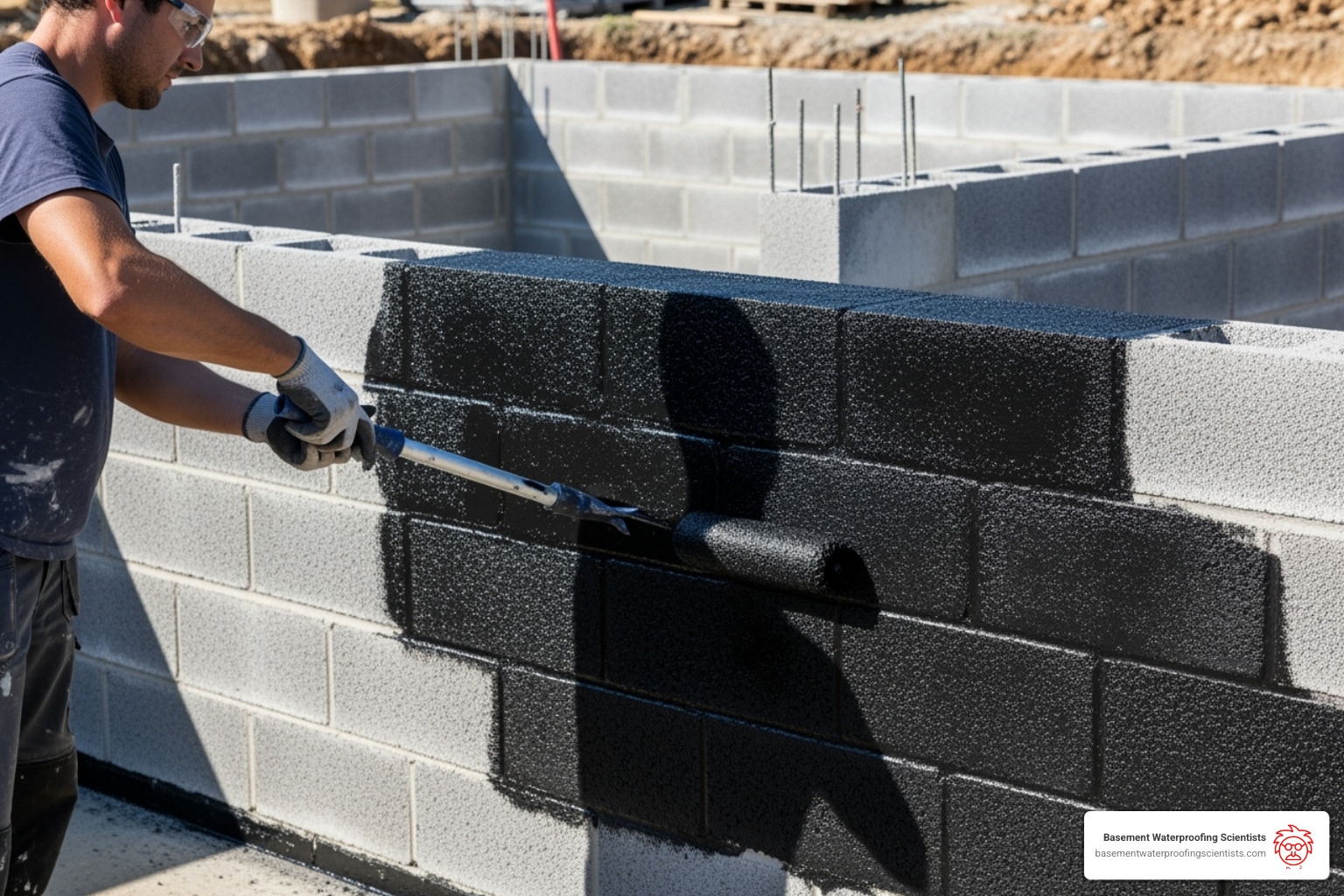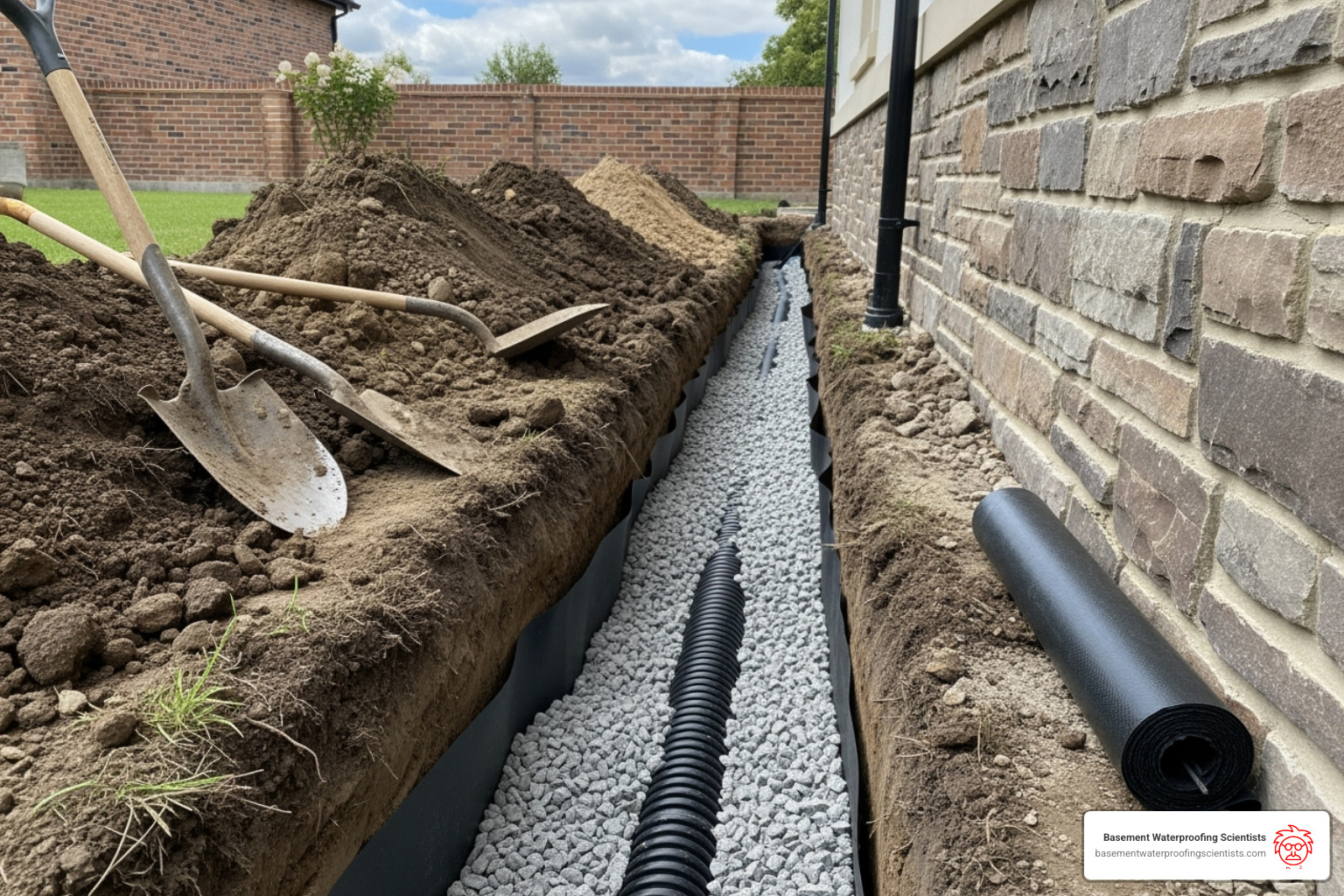Why Block Wall Foundations Are Water Magnets
Waterproofing block wall foundation is one of the most critical home maintenance tasks you’ll face as a homeowner. Block foundations are notorious for their vulnerability to water intrusion due to their porous nature and numerous mortar joints that create multiple pathways for moisture.
Quick Answer for Waterproofing Block Wall Foundation:
- Exterior Method: Excavate, clean wall, apply liquid membrane, install drainage system
- Interior Method: Install drainage channels, sump pump, and vapor barriers
- Complete System: Combine waterproofing with proper drainage and grading
- Average Cost: $4K-$8K for comprehensive basement waterproofing
The reality is sobering – concrete blocks are semi-permeable with a rating of 3.2 perms per inch, making them far more vulnerable than poured concrete walls. Once moisture gets into a block, it makes the pores even larger, creating a destructive cycle that can compromise your home’s structural integrity.
The hollow cores in concrete blocks can fill with water and create hydrostatic pressure that forces moisture through your walls. This leads to that familiar musty basement smell, mold growth, and water damage that can cost thousands in repairs if left untreated.
“Water always follows the path of least resistance, making cracks in block walls an easy route for water,” as foundation experts note. The mortar joints between blocks are particularly vulnerable, deteriorating over time and losing their effectiveness as water barriers.
I’m Darin Garvey, and with over 30 years of combined experience in waterproofing block wall foundation systems, I’ve seen how proper waterproofing transforms basements from damp, unusable spaces into dry, healthy environments. My team at Basement Waterproofing Scientists specializes in targeted solutions that address the unique challenges of block wall foundations.

Waterproofing block wall foundation glossary:
Why Block Foundations Leak: Understanding the Vulnerabilities
Concrete block foundations are truly unique in their construction and, unfortunately, their susceptibility to water. Unlike a monolithic poured concrete wall, a block foundation is built piece by piece, creating a network of vulnerabilities. We often refer to them as “water magnets” because of these inherent weaknesses.
At the heart of the issue is the material itself. Concrete blocks are porous, meaning they have tiny pathways that can absorb and wick water through a process called capillary action. While a 1:2:4 mix of concrete might have a permeability of 3.2 perms per inch, a thick poured concrete wall is significantly less permeable, often around 0.3 to 0.4 perms for an 8-10 inch wall. This stark difference means blocks naturally absorb and trap groundwater, especially as their hollow cores fill.
The mortar joints, which bind the blocks together, are another critical weak point. They are less durable than the concrete blocks themselves and will eventually start to deteriorate. As mortar loses its effectiveness, it creates more opportunities for water to seep through. Over time, tiny micro-cracks and capillaries form, allowing water to enter. This initial intrusion, combined with hydrostatic pressure (the force of water pushing against the foundation) and the relentless cycle of freezing and thawing, can make these tiny routes much larger, letting in more and more moisture.
When moisture intrudes into a block, it can make the pores even larger, reinforcing a destructive cycle. This constant dampness can lead to unsightly efflorescence – those white, powdery mineral deposits on the wall surface – and even spalling, where the surface of the concrete flakes off, further compromising the integrity of your foundation.

The Inherent Weakness of Concrete Blocks
Let’s dive a little deeper into why concrete blocks are so prone to moisture problems.
First, their semi-permeable nature is a fundamental challenge. As we’ve mentioned, concrete blocks have larger pores compared to poured concrete. This means they naturally absorb and hold groundwater. Imagine a sponge; concrete blocks act similarly, drawing moisture in.
Second, the hollow cores within the blocks are a double-edged sword. While they reduce material usage and allow for vertical rebar reinforcement, they also become reservoirs for water. As these hollow cores fill, water gets stuck inside and creates hydrostatic pressure. Over time, this pressure forces moisture to wick through the walls, leading to leaks, mold, and that all-too-familiar musty basement smell.
Finally, the sheer number of mortar joints in a block wall foundation presents more areas to seal than a poured concrete foundation. Each joint is a potential pathway for water. ASHRAE, a leading authority on building science standards, emphasizes that all concrete materials need protection from water intrusion, but concrete blocks and cinder blocks are especially vulnerable due to their larger pores and numerous joints.
Common Signs Your Block Foundation Needs Help
Your home often gives subtle (and not-so-subtle) hints that its waterproofing block wall foundation needs attention. Recognizing these signs early can save you from more extensive and costly repairs down the line.
Here are the red flags we look for:
- Visible Cracks: Even hairline cracks can be entry points for water. Larger, stepped cracks along the mortar joints are a clear indication of movement and potential water intrusion.
- Water Stains on Walls: Discoloration, streaks, or dark patches on your basement walls are tell-tale signs of moisture seepage.
- Puddles on the Floor: This is the most obvious sign. If you find standing water, even small puddles, after rain or snowmelt, your waterproofing has failed.
- High Humidity and Musty Smells: That damp, earthy odor in your basement isn’t just unpleasant; it’s a strong indicator of mold and mildew growth fed by excessive moisture. Our noses are excellent leak detectors!
- Peeling Paint or Wallpaper: If paint is bubbling or peeling off the basement walls, or wallpaper is detaching, it means moisture is pushing through from behind.
- Bowing or Bulging Walls: This is a more severe structural sign. Hydrostatic pressure can exert immense force, causing block walls to push inward. If you see this, it’s time to call the experts immediately.
These signs, whether subtle or alarming, all point to one thing: your block foundation is struggling to keep water out.
Dampproofing vs. Waterproofing: Choosing the Right Level of Protection
When we talk about protecting your waterproofing block wall foundation, it’s crucial to understand the difference between dampproofing and waterproofing. These terms are often used interchangeably, but they refer to very different levels of protection and are designed for distinct conditions.
Dampproofing is typically a black, asphalt-based coating applied to the exterior of a foundation wall. Its primary purpose is to resist moisture passage in the absence of hydrostatic conditions. Think of it as a barrier against soil moisture and humidity, not against active water pressure. Building codes often require dampproofing, but it’s a minimal defense. It might be sufficient for a dry crawl space with excellent drainage, but it won’t stand up to water actively pushing against the foundation.
Waterproofing, on the other hand, is designed to prevent water passage under hydrostatic pressure conditions. This means it can withstand the force of groundwater pushing against your foundation. True waterproofing involves more robust materials, such as liquid-applied membranes, sheet-applied membranes, or crystalline products, often applied in thicker layers and with more meticulous attention to detail. It’s a comprehensive system meant to keep your basement dry even when the water table is high or heavy rains create significant pressure.
Here’s a quick comparison:
| Feature | Dampproofing | Waterproofing |
|---|---|---|
| Purpose | Resist moisture/humidity | Prevent water passage under pressure |
| Application Method | Asphalt-based coating, spray or roll | Liquid-applied, sheet-applied, crystalline products |
| Cost | Lower initial cost | Higher initial cost |
| Effectiveness vs. Hydrostatic Pressure | Very limited, will fail under pressure | High, designed to withstand pressure |
| Building Codes | Often minimum code requirement | Exceeds code requirements, provides superior protection |
Choosing between the two depends heavily on your soil conditions, climate, and the presence (or potential for) hydrostatic pressure. For a waterproofing block wall foundation, especially in areas prone to heavy rain or high water tables, true waterproofing is always the superior choice.
A Comprehensive Guide to Waterproofing Block Wall Foundations
Achieving a truly dry basement with a waterproofing block wall foundation requires a systematic approach. We’re not just patching leaks; we’re creating a robust, long-lasting barrier against water. This typically involves several key stages: thorough excavation, meticulous surface preparation, precise crack repair, effective membrane application, and the integration of a comprehensive drainage system.
When we approach an exterior waterproofing block wall foundation project, our goal is to address the problem at its source – before water even reaches your foundation walls. This is often the most effective method for long-term protection.
To give you an idea of the process, here’s a detailed look at how we typically handle exterior foundation waterproofing, which you can learn more about in our guide on How to Waterproof Exterior Foundation Wall.

Preparing the Wall for a Perfect Seal
Before any waterproofing material touches your block wall, meticulous preparation is non-negotiable. This step is crucial because the longevity and effectiveness of the waterproofing membrane depend entirely on how well it adheres to the foundation. As the saying goes, “Fail to prepare, prepare to fail.”
Our preparation process involves:
- Removing the Soil: For exterior waterproofing, we first excavate the soil around the foundation, typically down to the concrete footing. This is a labor-intensive step, often 70-80 percent of the job, and requires careful work around utilities and landscaping.
- Power Washing and Debris Removal: Once exposed, the block wall is thoroughly cleaned. We use power washing to remove all dirt, loose mortar, efflorescence, old coatings, and any other contaminants that could impair adhesion. The goal is a clean, dry masonry surface.
- Grinding Rough Spots: Any significant protrusions or rough areas on the block wall are smoothed out using a grinding tool. This ensures an even surface for the membrane application.
- Filling Voids and Repairing Cracks: Concrete block walls often have voids, open mortar joints, and cracks. We carefully fill these with hydraulic cement, which sets quickly and expands to create a watertight seal. For larger structural cracks, we ensure they are addressed first. A high-quality product like M-1 Universal Adhesive Sealant can also be used to fortify joints and cracks, creating a smooth surface for the membrane. This step is vital because water always finds the path of least resistance.
- Curing Time: After repairs and void filling, we allow adequate curing time, typically 24 hours, to ensure the hydraulic cement or sealants have fully dried and hardened before applying any waterproofing membranes. We plan our work around dry weather conditions, as most waterproofing products require several days for proper drying and curing.
Exterior Waterproofing for a Block Wall Foundation
Once the wall is prepped, we move to the core of the waterproofing block wall foundation process: applying the exterior membrane. This is where we create the primary barrier against water intrusion.

We use highly engineered waterproofing products, chosen based on the specific conditions of your foundation and soil. Here are the main types we consider:
- Liquid-Applied Membranes: These are often rubberized asphaltic membranes or polymer-modified asphalt emulsions. They are sprayed, rolled, or troweled onto the block wall, forming a seamless, monolithic membrane that conforms to the wall’s irregularities. These products are highly elastic and can bridge minor cracks. Some modern formulations are water-based, making them safer to apply.
- Sheet-Applied Membranes: These are pre-formed sheets, typically made of rubberized asphalt sealed to a high-density polyethylene (HDPE) facer. They are peel-and-stick products, offering a uniform, factory-controlled thickness (e.g., 40-mil thick). These membranes are applied to a primed surface, overlapping seams by 2-3 inches to ensure watertightness. They provide immediate waterproofing and excellent puncture resistance.
- Dimple Board: After the primary waterproofing membrane is applied and cured, we install a dimple board. This is a semi-rigid plastic sheet with a dimpled surface that creates an air gap between the waterproofing membrane and the backfill soil. This air gap serves two crucial purposes: it protects the waterproofing membrane from damage during backfilling and, more importantly, it creates a clear drainage path for water to flow down to the perimeter drainage system, relieving hydrostatic pressure.
Backfilling Precautions: Once the waterproofing and dimple board are in place, careful backfilling is essential. We use clean, granular fill material, avoiding large rocks or debris that could damage the membrane. In some cases, sand is used directly against the dimple board for extra protection, especially if the native soil is rocky or clay-like.
The Cost to Excavate and Waterproof Foundation from the exterior can be a significant investment, but it’s a one-time solution that provides long-term peace of mind. While average costs for comprehensive basement waterproofing typically range between $4,000 and $8,000, exterior excavation is generally on the higher end of this spectrum due to the labor and equipment involved. However, it’s often the most effective solution for addressing the root cause of water intrusion.
Interior Solutions for a Block Wall Foundation
While exterior waterproofing block wall foundation is generally our preferred method for comprehensive protection, sometimes interior solutions are necessary or complementary, especially when exterior excavation isn’t feasible or cost-effective. These methods manage water that has already entered the basement, preventing it from causing damage within the living space.
Here’s how we approach interior waterproofing for block walls:
- Cementitious Coatings: Products like DRYLOK Extreme Concrete & Masonry Waterproofer are cement-based coatings that can be applied to the interior surface of block walls. They create a strong, water-resistant barrier that can stop water under moderate pressure. These coatings fill the pores of the blocks, effectively blocking water passage. They are suitable for masonry walls, brick, stucco, cinder, and concrete blocks. You can learn more about finding the Best Concrete Block Wall Waterproofer for your needs.
- Vapor Barriers: Once the wall is sealed, we might install a heavy-duty vapor barrier, often a thick polyethylene sheet, over the interior surface of the block wall. This barrier prevents any residual moisture or vapor from entering the living space, directing it down into an interior drainage system.
- Interior Drainage Channels: This is a critical component for managing hydrostatic pressure. We install a perimeter drainage system, often an interior French drain, along the base of the basement walls. This system collects water that seeps through the block walls or up from the floor/wall joint and channels it to a sump pump. For block walls, we can drill weep holes directly into the hollow cores of the blocks, allowing any trapped water to drain into the system.
- Sump Pumps: The collected water from the interior drainage channels is directed to a sump pump, which then automatically pumps the water out of the basement and away from the foundation. We always recommend a multi-pump system with a battery backup for reliable water removal, even during power outages.
Interior solutions manage water after it has entered the basement environment. While highly effective at keeping your basement dry, they don’t prevent the water from reaching the foundation walls. The Waterproofing Basement Walls from Inside Cost can vary, but it’s generally less expensive than exterior excavation. However, the best approach for a waterproofing block wall foundation often involves a combination of both interior and exterior strategies, custom to your home’s specific needs.
The Complete System: Drainage, Environment, and Best Practices
Waterproofing block wall foundation isn’t just about applying a product to a wall; it’s about creating a holistic system that manages water around your entire home. Neglecting external factors like soil conditions, climate, and basic home maintenance can undermine even the most robust waterproofing efforts.
We always consider the bigger picture because water management starts outside your home. Factors like the type of soil surrounding your foundation (clay retains water, sand drains quickly), the local climate (heavy rainfall, snowmelt), and even the pitch of your yard all play a significant role in how much water reaches your foundation.
For example, improperly maintained gutters and downspouts that dump water right next to your foundation are a common culprit for basement leaks. Similarly, if your yard slopes towards your house instead of away from it, you’re essentially funneling water directly to your foundation. These issues contribute to hydrostatic pressure and can overwhelm any waterproofing system over time.
This is why, as part of our comprehensive Foundation Repair and Waterproofing services, we always assess these external factors. We believe in fixing the problem, not just the symptom.

The Critical Role of Foundation Drainage
Drainage systems are the unsung heroes of a dry basement. Without proper drainage, even the best waterproofing membrane can be overwhelmed by relentless hydrostatic pressure. The goal of drainage is to collect water before it builds up against your foundation and direct it safely away.
Here’s how we typically ensure effective foundation drainage:
- French Drains (Perimeter Drains): These are subsurface drainage systems installed around the perimeter of your foundation, either on the interior or exterior. An exterior French drain consists of a trench filled with gravel, containing a perforated pipe. This pipe collects groundwater and channels it away from the foundation to a suitable discharge point. An interior French drain works similarly, collecting water that seeps through the foundation walls or up from the floor/wall joint and directing it to a sump pump.
- Sump Pumps: These devices are the workhorses of any interior drainage system. Once water is collected by the French drain, it flows into a sump pit where the sump pump resides. When the water level in the pit reaches a certain point, the pump automatically activates, ejecting the water through a discharge line away from your home. We often install multi-pump systems with battery backups to ensure continuous operation, even during power outages or heavy storms.
- Weeping Tile: This term is often used interchangeably with French drains, particularly in older construction. Weeping tile refers to the perforated pipes laid around the foundation footing to collect and drain groundwater. Ensuring these pipes are clear, properly sloped, and connected to a functioning discharge system is paramount.
The combination of a robust waterproofing membrane and an effective drainage system is what truly protects your waterproofing block wall foundation. The membrane acts as the primary barrier, while the drainage system relieves the pressure and safely removes any water that might bypass the membrane. This dual approach is key to keeping your basement consistently dry. You can find more detailed information on various approaches to Waterproofing Foundations.
Long-Term Success: Maintenance and Professional Guidance
Ensuring the longevity and effectiveness of your waterproofing block wall foundation isn’t a one-and-done deal. It’s a long-term commitment that involves ongoing awareness and, sometimes, professional intervention.
Here are some best practices for long-term success:
- Regular Inspections: Periodically inspect your basement walls, especially after heavy rains. Look for any new cracks, water stains, or signs of efflorescence. Check your drainage systems, ensuring downspouts are clear and directed away from the foundation.
- Maintain Grading and Gutters: Ensure the ground around your home slopes away from the foundation. Clean your gutters regularly to prevent overflow, and extend downspouts at least 5-10 feet away from the house. These simple steps significantly reduce the amount of water reaching your foundation.
- Stucco Application Precautions: If you’re considering applying stucco over a block wall, be aware that sealing the wall beforehand can be detrimental. Stucco needs some moisture to properly adhere to the substrate. If you seal the wall first, you risk trapping moisture between the wall and the stucco, leading to adherence issues and potential future problems. We advise against sealing block walls before stucco application.
- Combining Interior and Exterior Methods: While some may debate the necessity, combining interior and exterior waterproofing methods can offer the most comprehensive protection for a waterproofing block wall foundation. The exterior system prevents water from reaching the wall, while the interior system acts as a backup, managing any water that bypasses the exterior. The key is ensuring these systems work in harmony, not against each other. For example, a double vapor barrier (one inside, one outside, sandwiching the wall) can trap moisture within the wall, which is generally a bad idea. We recommend breathable barriers where appropriate to allow trapped moisture to escape.
-
DIY Considerations: For minor dampness or small crack repairs, a motivated homeowner can tackle some aspects. For example, applying a simple cementitious coating to the interior or re-grading a small area of yard. We’ve seen homeowners use simple tools like brushes, rollers, shovels, and pressure washers (which can be rented for about $100/day).
Here’s a list of recommended tools for a DIY project:- Shovel (for excavation)
- Pressure Washer (for cleaning)
- Stiff Brushes and Rollers (for applying coatings)
- Trowel (for hydraulic cement)
- Caulking Gun (for sealants)
- Safety Gear (gloves, eye protection, respirator for certain products)
- Buckets and Mixing Tools
- Wheelbarrow (for moving soil/gravel)
However, for extensive issues, active leaks, or major excavation, DIY can quickly become overwhelming and lead to costly mistakes. The work of exposing and replacing dirt can be approximately 70-80 percent of the job.
-
When to Call a Professional: If you’re experiencing significant leaks, bowing walls, persistent musty odors, or if you’re unsure about the source of your water problem, it’s time to call in the experts. Basement Waterproofing Scientists specializes in identifying leak sources using specialized equipment, allowing us to fix leaks for less. We offer expert inspections and customized solutions. Whether it’s an Exterior Foundation Wall issue or something more complex, our team has the 30 years of experience needed to diagnose and provide a lifetime guarantee on our work. We serve homeowners in Philadelphia, Reading, Norristown, Pottstown, Bensalem Township, Upper Darby Township, Bristol Township, Middletown Township, Lansdale, Warminster Township, Springfield Township, Haverford Township, Radnor Township, Willow Grove, King of Prussia, Horsham, Exeter Township, Cumru Township, Ardmore, Bryn Mawr, Quakertown, Royersford, Conshohocken, Hatboro, Collegeville, Pennsylvania, New Jersey, and Delaware.
Conclusion
The journey to a dry, healthy basement often begins with understanding the unique challenges presented by a waterproofing block wall foundation. We’ve seen how their porous nature, numerous mortar joints, and hollow cores make them particularly susceptible to water intrusion and the damaging effects of hydrostatic pressure and freeze-thaw cycles.
Effective waterproofing is never a single product or quick fix. It’s a comprehensive strategy that combines meticulous surface preparation, the application of robust exterior and/or interior membranes, and, crucially, a highly effective drainage system that manages water away from your home. From exterior excavation and membrane application to interior drainage channels, sump pumps, and vigilant maintenance of your home’s exterior, every component plays a vital role in protecting your investment.
At Basement Waterproofing Scientists, we understand that a dry basement isn’t just about preventing damage; it’s about peace of mind and reclaiming valuable living space. With our 30 years of experience, expert inspections, and commitment to competitive pricing, we’re dedicated to providing customized solutions that ensure your basement remains permanently dry, backed by our lifetime guarantee.
Don’t let seepage, musty smells, or the threat of water damage compromise your home any longer. Take the proactive step to protect your waterproofing block wall foundation and secure your home’s future.
Schedule your free inspection for exterior foundation waterproofing today!

